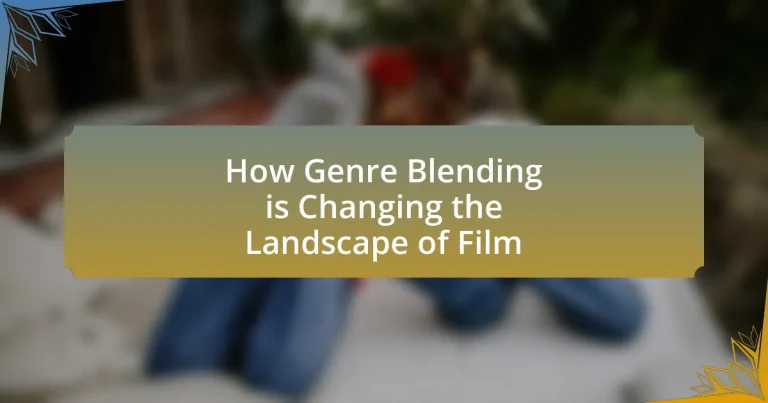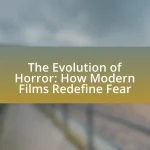Genre blending in film refers to the integration of elements from multiple genres to create innovative narratives that challenge traditional classifications. This article explores how genre blending differs from traditional genres, highlighting its characteristics and the reasons for its growing prevalence in modern cinema. It examines successful examples of genre-blending films, their impact on audience reception, and the evolving expectations of viewers. Additionally, the article addresses the challenges and criticisms filmmakers face when blending genres, while offering practical tips for effective genre fusion and discussing future trends influenced by technology and audience preferences.
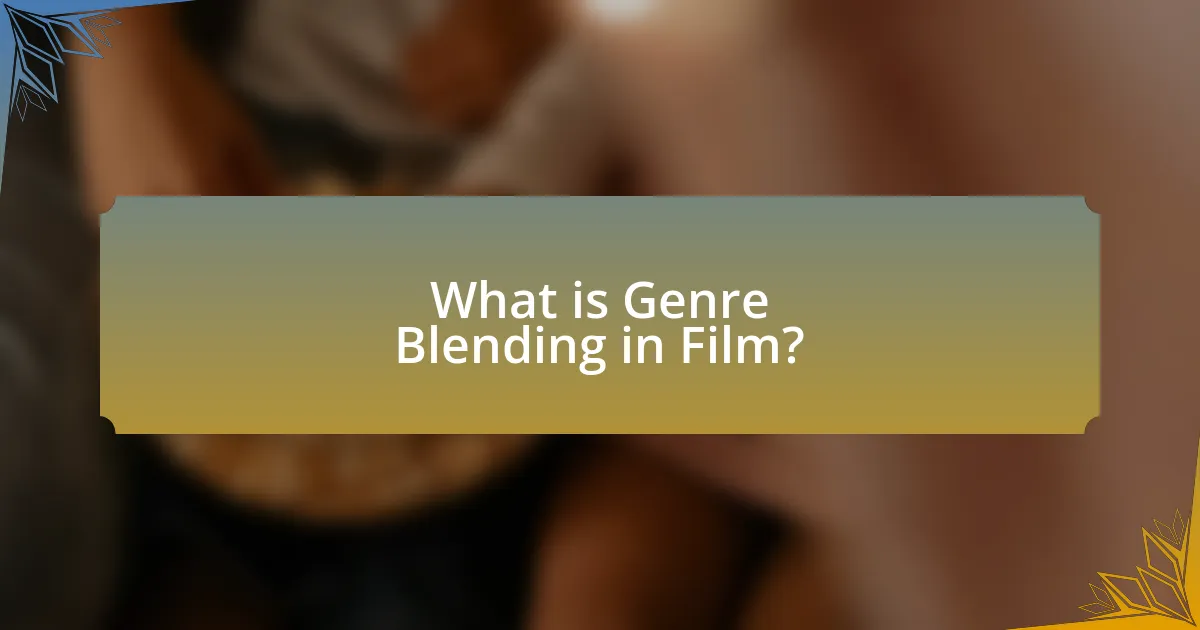
What is Genre Blending in Film?
Genre blending in film refers to the combination of elements from multiple genres to create a unique narrative experience. This technique allows filmmakers to explore diverse themes and storytelling methods, resulting in innovative films that defy traditional genre classifications. For example, movies like “Get Out” blend horror and social commentary, while “The Shape of Water” merges fantasy and romance. Such blending not only attracts a wider audience but also challenges conventional storytelling, reflecting the evolving nature of cinematic art.
How does Genre Blending differ from Traditional Genres?
Genre blending combines elements from multiple genres to create a hybrid narrative, while traditional genres adhere to specific conventions and themes. Traditional genres, such as drama, comedy, or horror, follow established rules that define their structure and audience expectations. In contrast, genre blending allows filmmakers to mix these conventions, resulting in innovative storytelling that can appeal to a broader audience. For example, films like “Get Out” merge horror with social commentary, challenging the norms of both genres and expanding the possibilities of cinematic expression. This approach reflects a shift in audience preferences towards more complex narratives that defy categorization, demonstrating how genre blending is reshaping the film landscape.
What are the characteristics of Genre Blending?
Genre blending is characterized by the combination of elements from two or more distinct genres to create a hybrid narrative. This approach often results in innovative storytelling techniques, diverse character development, and unique thematic explorations. For instance, films like “Get Out” merge horror with social commentary, showcasing how genre blending can enhance emotional depth and audience engagement. Additionally, genre blending allows for greater creative freedom, enabling filmmakers to challenge traditional genre conventions and appeal to broader audiences.
Why is Genre Blending becoming more prevalent in modern cinema?
Genre blending is becoming more prevalent in modern cinema due to audience demand for innovative storytelling and the desire for fresh experiences. As viewers increasingly seek unique narratives that combine elements from different genres, filmmakers respond by merging genres to create films that appeal to diverse tastes. This trend is supported by the success of films like “Get Out,” which blends horror and social commentary, and “Mad Max: Fury Road,” which combines action and drama, demonstrating that genre blending can attract wider audiences and enhance box office performance. Additionally, advancements in technology and streaming platforms facilitate the exploration of hybrid genres, allowing creators to experiment and reach niche markets effectively.
What are some examples of successful Genre Blending films?
Some examples of successful genre blending films include “Get Out,” which combines horror and social commentary, and “The Shape of Water,” blending fantasy and romance. “Pulp Fiction” is another notable example, merging crime and drama with non-linear storytelling. These films have achieved critical acclaim and commercial success, demonstrating the effectiveness of blending genres to create unique narratives that resonate with audiences. For instance, “Get Out” received an Academy Award for Best Original Screenplay, highlighting its impact and innovation within the horror genre.
How do these films combine different genres effectively?
These films combine different genres effectively by integrating elements from multiple genres to create a cohesive narrative that appeals to diverse audiences. For instance, films like “Get Out” blend horror and social commentary, using suspenseful elements to highlight racial issues, which enhances both the emotional impact and the thematic depth. This genre fusion allows filmmakers to explore complex themes while maintaining audience engagement through familiar genre conventions, thereby broadening the film’s appeal and enhancing its cultural relevance.
What impact have these films had on audience reception?
Genre-blending films have significantly altered audience reception by expanding viewer expectations and preferences. These films often combine elements from multiple genres, leading to innovative storytelling that attracts diverse audiences. For instance, the success of films like “Get Out,” which blends horror and social commentary, has demonstrated that audiences are receptive to narratives that challenge traditional genre boundaries. This shift is supported by box office statistics showing increased revenue for genre-blending films, indicating a growing demand for unique cinematic experiences. Additionally, audience engagement on social media platforms reflects heightened interest in discussing and analyzing these hybrid films, further illustrating their impact on reception.
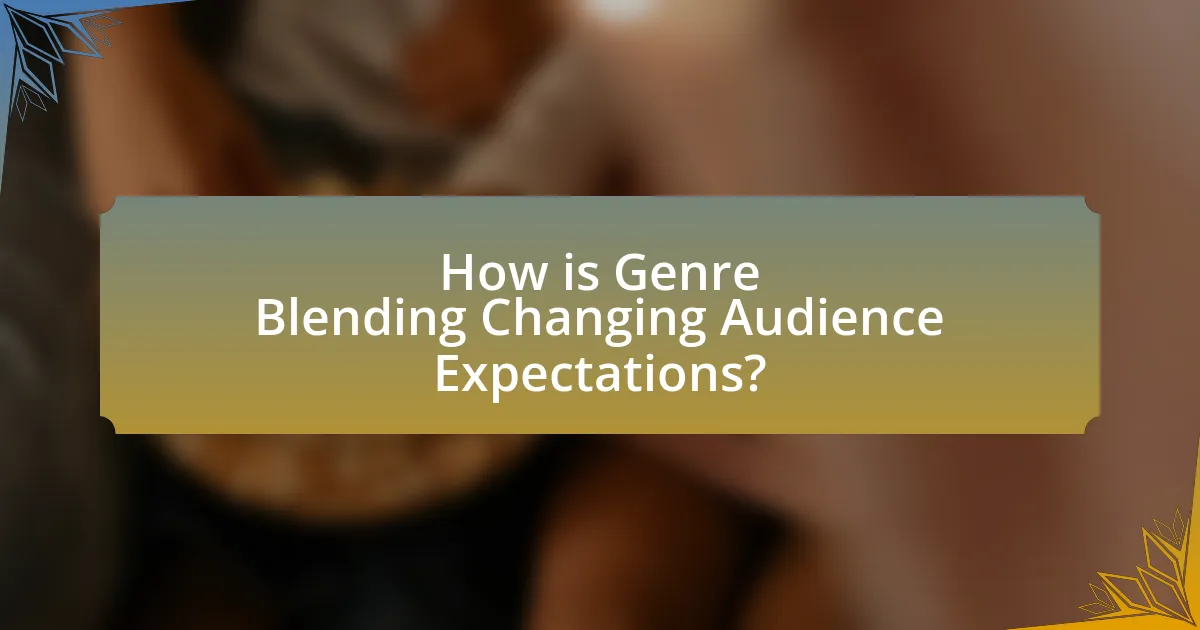
How is Genre Blending Changing Audience Expectations?
Genre blending is changing audience expectations by creating a demand for more innovative and unpredictable storytelling. As films increasingly combine elements from multiple genres, viewers now anticipate narratives that defy traditional conventions, leading to a desire for complexity and depth in character development and plot structure. For instance, films like “Get Out,” which blends horror with social commentary, have set a precedent, demonstrating that audiences appreciate and expect films that challenge genre norms. This shift is supported by box office trends showing that genre-blending films often outperform traditional genre films, indicating a clear change in what audiences seek from cinematic experiences.
What new narratives are emerging from Genre Blending?
New narratives emerging from genre blending include complex character arcs, innovative storytelling techniques, and the exploration of diverse themes that transcend traditional genre boundaries. For instance, films like “Get Out” blend horror and social commentary, creating a narrative that addresses racial tensions while engaging audiences through suspense. This blending allows filmmakers to challenge conventions, resulting in stories that resonate on multiple levels and reflect contemporary societal issues. The success of such films demonstrates the effectiveness of genre blending in crafting narratives that are both entertaining and thought-provoking.
How do these narratives challenge traditional storytelling methods?
Narratives that blend genres challenge traditional storytelling methods by subverting established conventions and expectations. For instance, films that combine elements of horror and comedy, such as “Get Out,” disrupt the typical narrative arcs associated with each genre, creating a unique viewing experience that defies categorization. This blending often leads to innovative character development and plot structures, as seen in works like “The Shape of Water,” which merges fantasy and romance, thereby expanding the emotional and thematic depth of the story. By doing so, these narratives not only attract diverse audiences but also encourage filmmakers to explore new creative avenues, ultimately reshaping the landscape of film.
What themes are commonly explored in blended genres?
Blended genres commonly explore themes such as identity, conflict, and transformation. These themes arise from the fusion of different genre conventions, allowing for a richer narrative experience. For instance, the blending of horror and comedy often examines the absurdity of fear, while combining romance and science fiction can delve into the complexities of love in unfamiliar contexts. This thematic exploration is evident in films like “Get Out,” which merges horror with social commentary, highlighting racial tensions, and “Eternal Sunshine of the Spotless Mind,” which blends romance and science fiction to explore memory and identity.
How does Genre Blending influence film marketing and distribution?
Genre blending influences film marketing and distribution by expanding target audiences and creating unique selling propositions. Films that combine elements from multiple genres can attract diverse viewer demographics, as seen with movies like “Get Out,” which blends horror and social commentary, appealing to both horror fans and those interested in social issues. This broader appeal allows marketers to craft multifaceted campaigns that highlight various aspects of the film, increasing its visibility across different platforms. Additionally, genre-blended films often benefit from cross-genre partnerships and promotional strategies, enhancing distribution opportunities in both traditional and digital markets. For instance, the success of “The Shape of Water,” which merges fantasy and romance, demonstrates how genre blending can lead to critical acclaim and commercial success, further validating its impact on marketing and distribution strategies.
What strategies are used to promote Genre Blending films?
Promotional strategies for genre blending films include targeted marketing campaigns, leveraging social media platforms, and engaging with niche audiences. Targeted marketing campaigns focus on identifying and reaching specific demographics that appreciate hybrid genres, often utilizing data analytics to tailor messages. Social media platforms serve as effective tools for building buzz and community engagement, allowing filmmakers to share trailers, behind-the-scenes content, and interactive posts that resonate with fans of multiple genres. Engaging with niche audiences through film festivals and genre-specific events helps create a dedicated viewer base, as these platforms often celebrate innovative storytelling that defies traditional genre boundaries.
How do distributors approach Genre Blending films differently?
Distributors approach genre blending films by tailoring marketing strategies to highlight the unique elements of multiple genres, thereby attracting diverse audience segments. For instance, they may emphasize action-packed sequences in a sci-fi comedy to appeal to both action and comedy fans, leveraging the film’s hybrid nature to broaden its market reach. This strategy is supported by data showing that genre-blending films, such as “Get Out,” which combines horror and social commentary, often perform better at the box office due to their ability to engage varied demographics, thus validating the effectiveness of targeted marketing in this context.
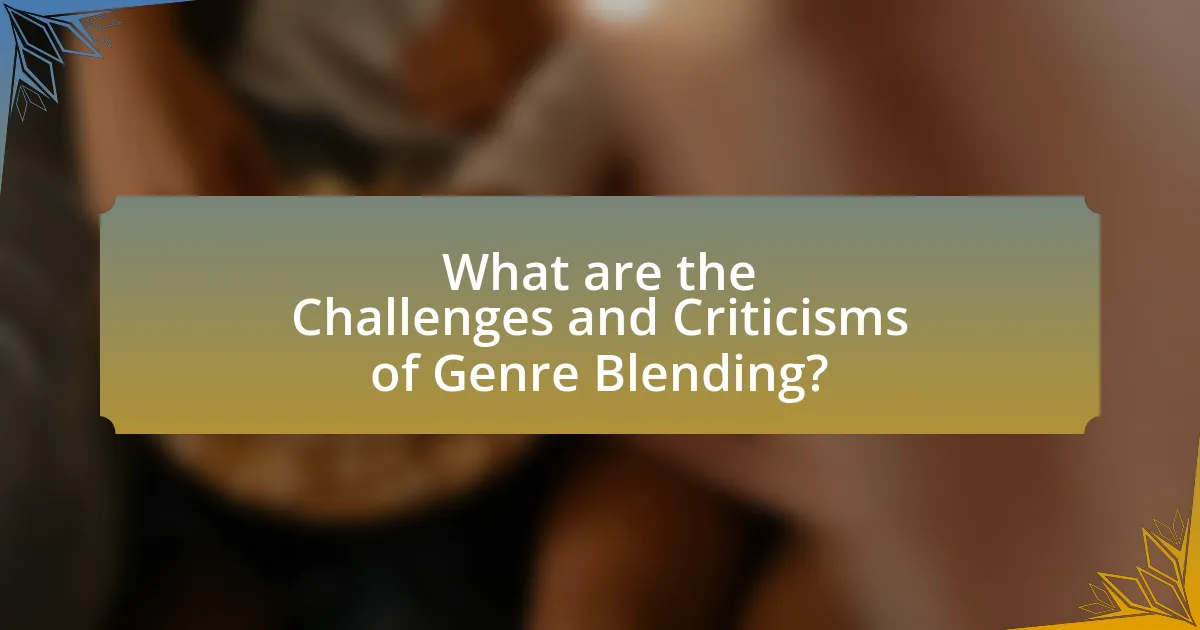
What are the Challenges and Criticisms of Genre Blending?
Genre blending faces challenges and criticisms primarily due to audience expectations and marketing difficulties. Audiences often have preconceived notions about specific genres, which can lead to confusion or dissatisfaction when elements from different genres are combined. For instance, a film that mixes horror and comedy may alienate viewers who prefer a traditional approach to either genre. Additionally, marketing such films can be problematic, as it becomes challenging to target the right demographic when the film does not fit neatly into a single category. This complexity can result in reduced box office performance, as seen in films like “The Cabin in the Woods,” which struggled to find its audience despite critical acclaim. Furthermore, critics may argue that genre blending can dilute the thematic depth of individual genres, leading to a lack of coherence in storytelling.
What are the common criticisms of Genre Blending in film?
Common criticisms of genre blending in film include a perceived lack of coherence, dilution of genre conventions, and audience confusion. Critics argue that blending genres can lead to narratives that feel disjointed, as the tonal shifts may disrupt the viewer’s engagement. Additionally, some believe that mixing genres can weaken the distinct characteristics that define each genre, resulting in a film that fails to satisfy fans of either genre. Audience confusion often arises when viewers have difficulty categorizing a film, which can affect their expectations and enjoyment. These criticisms highlight the challenges filmmakers face in balancing multiple genres while maintaining clarity and coherence in storytelling.
How do critics argue that Genre Blending affects film quality?
Critics argue that genre blending enhances film quality by allowing for greater creativity and innovation in storytelling. This approach enables filmmakers to combine elements from different genres, resulting in unique narratives that can engage audiences on multiple levels. For instance, films like “Get Out” blend horror with social commentary, which not only entertains but also provokes thought, demonstrating how genre fusion can elevate thematic depth. Additionally, genre blending can attract diverse audiences, as seen with “The Shape of Water,” which merges fantasy and romance, appealing to fans of both genres. This cross-pollination of styles often leads to fresh cinematic experiences, ultimately contributing to the evolution of film as an art form.
What challenges do filmmakers face when blending genres?
Filmmakers face several challenges when blending genres, primarily including audience expectations, tonal consistency, and narrative coherence. Audience expectations can create pressure to adhere to established conventions of each genre, making it difficult to innovate without alienating viewers. Tonal consistency is crucial, as mismatched tones can confuse audiences and detract from the overall experience; for instance, a film that shifts abruptly from comedy to horror may fail to resonate. Narrative coherence is also a significant challenge, as merging different genre elements requires a seamless integration of plot devices and character arcs to maintain engagement and clarity. These challenges highlight the complexity of genre blending in filmmaking, necessitating careful consideration and execution to achieve a successful outcome.
How can filmmakers effectively navigate the challenges of Genre Blending?
Filmmakers can effectively navigate the challenges of genre blending by establishing a clear thematic focus that resonates across multiple genres. This approach allows filmmakers to create a cohesive narrative that appeals to diverse audiences while maintaining the integrity of each genre involved. For instance, films like “Get Out” successfully blend horror and social commentary, demonstrating that a strong thematic foundation can unify contrasting elements. Additionally, filmmakers should study successful genre hybrids, such as “The Shape of Water,” which combines fantasy and romance, to understand how to balance tone and style. By analyzing audience reactions and box office performance, filmmakers can refine their techniques, ensuring that genre blending enhances rather than dilutes the storytelling experience.
What best practices can be adopted for successful Genre Blending?
Successful genre blending can be achieved by maintaining a clear thematic focus while integrating elements from different genres. This involves identifying core themes that resonate across genres, ensuring that the narrative remains cohesive and engaging. For instance, films like “Get Out” effectively blend horror and social commentary, demonstrating how a strong thematic foundation can unify diverse genre elements. Additionally, understanding audience expectations for each genre allows creators to subvert or fulfill these expectations strategically, enhancing the overall impact of the film. By studying successful examples and audience reactions, filmmakers can refine their approach to genre blending, ensuring that the final product resonates with viewers while pushing creative boundaries.
How can filmmakers balance audience expectations with creative expression?
Filmmakers can balance audience expectations with creative expression by integrating familiar genre elements while introducing innovative storytelling techniques. This approach allows filmmakers to meet audience desires for recognizable themes and structures, as seen in successful films like “Get Out,” which blends horror with social commentary, appealing to both genre fans and those seeking deeper narratives. By leveraging audience familiarity with genre conventions, filmmakers can experiment with unique perspectives and narratives, thus fostering creativity without alienating viewers. This balance is crucial in an evolving film landscape where genre blending is increasingly popular, as evidenced by the rise of films that successfully merge multiple genres, attracting diverse audiences while maintaining artistic integrity.
What are the future trends in Genre Blending?
Future trends in genre blending include the increasing integration of technology, such as virtual reality and augmented reality, which allows for immersive storytelling that combines elements from multiple genres. Additionally, the rise of streaming platforms is fostering experimentation with genre combinations, as creators seek to attract diverse audiences. Data from the 2022 Film Industry Report indicates that films blending genres like horror-comedy and sci-fi-drama have seen a significant increase in viewership, reflecting audience preferences for innovative narratives. Furthermore, the influence of global cinema is leading to cross-cultural genre fusions, enriching the storytelling landscape and expanding the boundaries of traditional genres.
How might technology influence the evolution of Genre Blending?
Technology significantly influences the evolution of genre blending by enabling creators to experiment with and combine diverse narrative styles and techniques. Advances in digital filmmaking, such as CGI and editing software, allow filmmakers to seamlessly integrate elements from various genres, creating hybrid forms that appeal to broader audiences. For instance, the rise of streaming platforms has facilitated the production and distribution of genre-blending films, as seen in works like “Get Out,” which combines horror and social commentary, reflecting contemporary societal issues. This technological shift not only enhances creative possibilities but also reshapes audience expectations, encouraging further exploration of genre boundaries.
What emerging genres are likely to blend in the coming years?
Emerging genres likely to blend in the coming years include sci-fi horror and psychological thriller, as filmmakers increasingly explore complex narratives that combine elements of fear with futuristic themes. This trend is supported by the success of films like “Get Out,” which merges social commentary with horror, indicating a growing audience interest in genre fusion. Additionally, the rise of animated documentaries showcases a blend of animation and non-fiction storytelling, appealing to diverse viewer preferences and expanding the boundaries of traditional genres.
What practical tips can filmmakers use to explore Genre Blending?
Filmmakers can explore genre blending by identifying and combining elements from different genres to create unique narratives. This can be achieved by analyzing successful genre-blending films, such as “Get Out,” which merges horror and social commentary, demonstrating how thematic depth can enhance genre conventions. Additionally, filmmakers should experiment with character archetypes and plot structures from various genres, allowing for innovative storytelling techniques. Collaborating with writers and artists from diverse backgrounds can also provide fresh perspectives and ideas, further enriching the genre-blending process.
